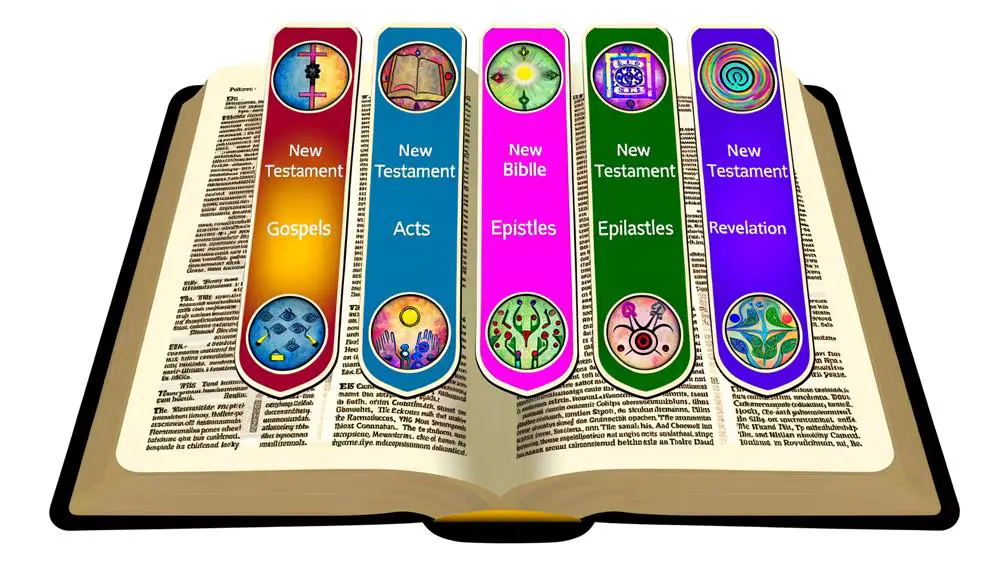Journey through the fascinating structure of the Bible's chapters to uncover hidden depths and historical shifts—discover what lies beneath.

How Chapters Are in the Bible
Interestingly, you've probably opened the Bible as many times as there are chapters within it, without realizing the depth of its structural complexity.
You're likely aware that it's divided into the Old and New Testaments, but the intricacies of its chapters, which vary across different editions and translations, are less commonly understood.
This layered organization not only reflects historical contexts but also influences how you navigate its teachings today. To truly appreciate the Bible's composition, understanding the rationale behind its chapter divisions and how they've evolved over time is crucial.
Let's explore this further, shall we?
Key Takeaways
- The Bible contains a total of 1,189 chapters spread across the Old and New Testaments.
- Chapter divisions vary by edition due to translation differences and denominational preferences.
- The Old Testament has 929 chapters, while the New Testament includes 260 chapters.
- Chapter and verse divisions were added for ease of reference, not originally part of the manuscripts.
Understanding Biblical Structure

To grasp the complexity of the Bible, it's crucial to first understand its intricate structure, which serves as the foundation for its profound spiritual and historical narratives. This structure isn't merely a compilation of books but a carefully woven tapestry of texts, each contributing to the overarching message. Yet, understanding this structure isn't straightforward, primarily due to translation challenges and the diverse origins of the manuscripts.
Delving into manuscript origins reveals a mosaic of sources. These texts originated across different times, regions, and languages, reflecting the diverse cultural contexts of their authors. The manuscripts, written on papyrus, parchment, and other materials, have been subject to the ravages of time, leading to variations and discrepancies. Scholars dedicate their lives to piecing together these fragments, striving to reconstruct the original messages.
Translation challenges further complicate this endeavor. Translating ancient texts isn't simply about converting words from one language to another; it's about capturing the essence, the cultural nuances, and the underlying meanings of the original texts. Each translation reflects the translator's interpretations and the linguistic conventions of their time, leading to multiple versions of the Bible. These versions, while aiming to be faithful to the original texts, inevitably introduce variations, influencing how readers understand its structure and message.
Thus, understanding the Bible's structure involves navigating the complexities of its manuscript origins and the challenges of translation. This foundation is vital for anyone seeking to fully appreciate the depth and breadth of the biblical narratives and their significance in spiritual and historical contexts.
The Old Testament Chapters

You'll find that the Old Testament encompasses a significant portion of the Bible's total chapter count, presenting a complex tapestry of religious, historical, and cultural narratives.
An overview of its most notable books reveals not only the depth and diversity of theological thought but also the historical context shaping this compilation.
The reasons behind chapter variation within these texts stem from a myriad of factors, including translation practices, manuscript traditions, and theological interpretations, underscoring the intricate process of canon formation.
Total Chapter Count
The Old Testament, a cornerstone of Judeo-Christian scripture, comprises a total of 929 chapters, each contributing to the foundational narrative and theological teachings central to these faiths. Understanding the chapter origins and employing effective reading strategies are essential in navigating this extensive compilation.
Here are four analytical insights to enhance your study:
- Chapter Breakdown: The division into chapters wasn't original but was later introduced for easier navigation and study.
- Historical Context: Each chapter reflects a unique historical period, offering insights into the lives and beliefs of ancient communities.
- Theological Themes: Identifying recurring theological themes helps in understanding the overarching narrative.
- Reading Approaches: Adopting thematic, chronological, or canonical reading strategies can significantly improve comprehension and retention.
These elements collectively enrich your exploration of the Old Testament's chapters.
Notable Books Overview
Delving into the Old Testament, one encounters a diverse array of books, each with its unique thematic and historical significance, offering a rich tapestry of narratives that underpin the foundational beliefs and teachings of Judeo-Christian traditions.
The Old Testament showcases a remarkable range of book themes, from the law-giving texts of Leviticus to the poetic and philosophical musings found in Ecclesiastes. This diversity is further enriched by the varied backgrounds and periods of the authors, contributing to a multifaceted portrayal of spiritual life and human experience.
Author diversity in the Old Testament introduces readers to a spectrum of perspectives, from royal courts to exile communities, each adding depth and complexity to the overarching narrative. This blend of thematic variety and authorial voices underscores the Old Testament's enduring relevance and scholarly intrigue.
Chapter Variation Reasons
Exploring the Old Testament further reveals that the reasons behind the variation in chapter numbers across its books stem from historical, linguistic, and theological factors. These discrepancies can be attributed to several key elements:
- Translation impact: Different translation philosophies can lead to variations in how texts are divided, influencing chapter count.
- Manuscript differences: Variations in ancient manuscripts may result in differing chapter divisions based on textual discrepancies.
- Linguistic considerations: The original Hebrew and Aramaic texts have unique structural features that affect chapter delineation.
- Theological interpretations: Scholars' theological perspectives can influence how texts are divided into chapters, based on thematic or doctrinal considerations.
These factors collectively contribute to the complex nature of chapter variation within the Old Testament.
The New Testament Breakdown

You'll find that the New Testament consists of distinct sections: the Gospels, the Letters (Epistles), and the Book of Revelation. Each segment serves a unique purpose, with the Gospels chronicling the life and teachings of Jesus Christ, while the Letters address the theological and practical aspects of Christian faith and conduct.
Lastly, Revelation offers a prophetic and apocalyptic vision of the end times, distinct in its symbolic and allegorical content.
Gospels Overview
The Gospels, comprising Matthew, Mark, Luke, and John, form the cornerstone of the New Testament, presenting the life, teachings, death, and resurrection of Jesus Christ in four distinct narratives. Each Gospel provides unique insights and emphasizes different aspects of Jesus' life:
- Matthew highlights Jesus as the fulfillment of messianic prophecies, connecting Old Testament predictions to His ministry.
- Mark offers a concise account, emphasizing Jesus' actions and miracles, portraying Him as the Messiah in action.
- Luke presents a detailed narrative focused on Jesus' parables and teachings, appealing to a Gentile audience by highlighting Jesus' compassion.
- John emphasizes the divinity of Jesus, focusing on His identity as the Son of God through theological reflections rather than parables.
This analytical approach reveals the multifaceted portrayal of Jesus, inviting believers and scholars alike to explore the depths of His message and mission.
Letters and Revelation
Following the Gospels, twenty-one letters and the book of Revelation constitute the remainder of the New Testament, offering a complex mosaic of theological insights, pastoral advice, and apocalyptic visions that have profoundly shaped Christian doctrine and practice.
The epistle authors, including Paul, Peter, James, John, and Jude, communicate with early Christian communities, addressing theological disputes, moral conduct, and the nature of Christ's followership. Their letters, rich with doctrinal elaboration, serve as foundational texts for Christian ethics and ecclesiology.
The book of Revelation, with its vivid apocalyptic imagery, presents a cosmic narrative of the end times, encouraging perseverance amid persecution. This segment of the New Testament, with its intricate blend of personal letters and eschatological prophecy, underscores the diverse yet unified nature of early Christian thought.
Variations Across Different Editions

Diverse editions of the Bible present variations in chapter count, reflecting differences in textual traditions and translation choices. When you delve into the world of biblical translations, you'll uncover a rich tapestry of history and belief systems guiding these variations. Translation differences and edition preferences play crucial roles in shaping the Bible you might be familiar with today. These variations aren't arbitrary but stem from deep scholarly work and theological perspectives, making each edition of the Bible unique in its way.
Here are four key points to consider regarding these variations:
- Translation Differences: The original texts of the Bible were written in Hebrew, Aramaic, and Greek. As translators work to convert these texts into contemporary languages, their interpretations can lead to variations in chapter division. Translation committees may decide to split or combine chapters based on linguistic and theological considerations.
- Edition Preferences: Different Christian denominations and traditions may prefer certain editions of the Bible, which can influence the chapter count. For example, Catholic, Protestant, and Orthodox Bibles include different books, and thus, their chapter counts vary.
- Textual Traditions: Manuscripts of biblical texts have been transmitted through centuries, with variations emerging over time. These textual traditions can influence how chapters are numbered and arranged.
- Scholarly Interpretation: Biblical scholars often revisit and revise translations based on new archaeological findings or advances in understanding ancient languages. Such revisions can lead to changes in how chapters are structured.
Understanding these factors provides insight into why there isn't a one-size-fits-all answer to how many chapters are in the Bible. Each edition reflects a complex interplay of history, theology, and linguistics.
Historical Context and Chapter Addition

Delving into the historical context, you'll find that the addition of chapters to the Bible was a pivotal development, stemming from a meticulous process of scholarly effort and ecclesiastical need. The manuscript evolution of this sacred text reveals a complex journey, marked by a series of adaptations and revisions aimed at making the scriptures more accessible and understandable to both clergy and laypeople. This task wasn't merely academic; it served a profoundly practical purpose in the liturgical and educational domains.
The division into chapters as we know it today didn't emerge until the Middle Ages, a time characterized by a heightened zeal for theological study and scripture dissemination. This structuring was catalyzed by the need for a standardized way to reference and discuss scriptural passages across the growing network of Christian communities. It's fascinating to note that these divisions weren't part of the original manuscripts but were introduced to facilitate easier navigation and memorization of the text.
Moreover, the impact of translation on this structuring process can't be overstated. As the Bible was translated into various languages, from the Vulgate Latin to the vernacular tongues of Europe, the chapter divisions played a crucial role in ensuring consistency and comprehension across linguistic and cultural boundaries. This aspect of manuscript evolution was instrumental in shaping the way the Bible was studied, interpreted, and experienced across different epochs and societies.
Navigating the Chapters Today

With the historical evolution of chapter divisions in mind, let's explore how these sections are navigated in the contemporary context. The advent of digital platforms and the shifting reading habits have significantly influenced how individuals engage with the Bible today. This transformation isn't merely technological but also cultural, affecting the accessibility, interpretation, and dissemination of biblical chapters.
Here are four key ways in which the navigation of Bible chapters has evolved:
- Digital Accessibility: Digital platforms have made the Bible more accessible than ever. You can now easily search for specific chapters or verses, compare different translations side by side, and even listen to audio versions. This has democratized access to biblical texts, allowing for an unprecedented level of engagement and study.
- Reading Habits: The shift towards digital consumption has also changed reading habits. Individuals are more likely to read shorter passages or specific chapters that resonate with their current life situations, rather than engaging in linear reading from Genesis to Revelation.
- Interactive Study Tools: Many digital platforms offer interactive study tools, such as commentary, cross-references, and original language tools right alongside the chapter text. This enhances understanding and encourages deeper exploration of chapters and verses.
- Community Engagement: Social media and online forums have facilitated discussions around specific Bible chapters among diverse global communities. This collective engagement offers varied interpretations and applications, enriching the reading experience.
Frequently Asked Questions
How Does the Chapter Division in the Bible Influence Modern Religious Practices and Interpretations?
Chapter divisions significantly shape your engagement with religious texts, guiding interpretations and practices. The history of chapter numbering has evolved, making modern navigation tools crucial for study and reference.
This structuring influences how you perceive and apply scripture, affecting theological discourse and personal faith. By segmenting text, chapters offer a framework that shapes understanding, allowing deeper analysis and facilitating communal discussions, thereby molding both individual and collective religious experiences.
Are There Any Lost or Hidden Chapters That Were Not Included in the Standard Editions of the Bible?
Ironically, you'd think every sacred word made the final cut, yet history tells a different tale.
Throughout Canon formation, numerous texts were left in the shadows, not quite fitting the spiritual narrative. These apocryphal texts, often shrouded in mystery, offer a glimpse into what didn't make the ecclesiastical cut.
They challenge and enrich our understanding, proving that the process wasn't just divine inspiration but a complex, human endeavor.
How Do Different Religious Denominations Approach the Reading and Study of Chapters That Are Controversial or Difficult to Interpret?
You'll find that different religious denominations tackle challenging or controversial chapters through interfaith dialogues and scholarly analysis. They don't shy away from scriptural inconsistencies but instead delve into them, seeking deeper understanding and common ground.
Through rigorous study and open discussions, they aim to interpret these texts in ways that resonate with their faith's core principles, while also considering historical and cultural contexts. This approach enriches their spiritual journey and fosters greater unity.
Can the Emotional or Spiritual Impact of Reading the Bible Be Affected by the Way Chapters Are Organized or Divided?
Absolutely, the way chapters are numbered and organized can shape your emotional or spiritual journey through the Bible.
Imagine each chapter as a stepping stone in a garden; the pace at which you travel and the path you take can deeply influence your reflections and insights.
Chapter numbering not only guides your reading pace but also frames your understanding, allowing for a more profound exploration of themes and teachings within this sacred text.
How Have Bible Chapters Been Adapted or Used in Other Forms of Media, Such as Film, Literature, or Art, and What Impact Does This Have on Cultural Perceptions of the Bible?
Bible chapters have been transformed into cinematic adaptations and artistic interpretations, profoundly impacting cultural perceptions. These adaptations often recontextualize stories, making them more accessible or relatable to contemporary audiences.
Conclusion
In conclusion, navigating the Bible's chapters involves understanding its structure, from the Old to the New Testament, and recognizing variations across editions. Historically, chapters were added for easier reference, a practice that has shaped how we engage with the text today.
Consider the case of the Codex Sinaiticus, an ancient manuscript that reveals early attempts at organization. Analyzing such examples underscores the importance of chapters in accessing the Bible's teachings, highlighting the intricate relationship between form and religious scholarship.



Sign up